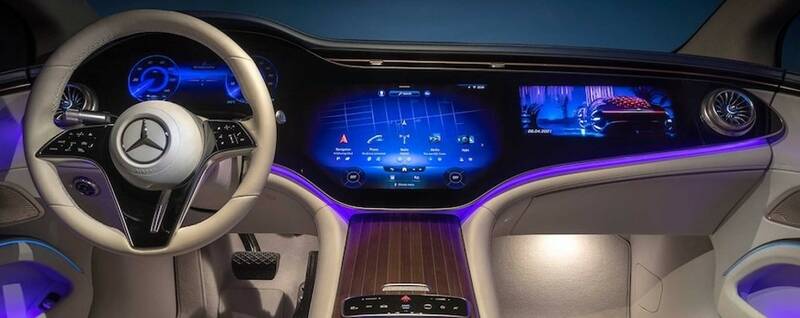Dashboards of the Future are Here: Pillar-to-Pillar Displays
Ever since the first digital display appeared in an automobile—in the 1976 Aston Martin—the amount of vehicle real estate dedicated to displays has grown dramatically. The 2012 Tesla included the first automotive touch-screen display. At 17" diagonal it ushered in a new era of larger display panels in the vehicle. In the last several years, the industry has evolved rapidly in both the number and size of displays in the cockpit, including instrument cluster displays, center stack, and passenger infotaiment displays.
In 2021, suppliers and automakers began showing new display designs that stretched accross the entire width of the dashboard, from one A-pillar to the other. These new pillar-to-pillar (P2P) displays can measure more than a meter wide. They are now in several vehicles on the market and planned for more within the next two years. In fact, from just $36M in 2022, the P2P display market is forecast to increase 46.2% CAGR through 2032 to reach $1.65B.1

Mercedes-Benz 2022 EQS 56” “Hyperscreen” includes an LCD instrument cluster display and two flexible OLED screens for center-stack and passenger displays, with all panels bonded under a single sheet of cover glass. (Image ©Mercedes-Benz)
P2P displays are said to provide an "immersive" experience for the driver. Typically these dashboards integrate multiple component displays beneath a single sheet of touchscreen glass. So far, only a few P2P displays have been launched, in the 2023 Cadillac Celestiq and in the 2022 and 2023 Mercedes-Benz EQS. Produced by LG Displays, the EQS "hyperscreen" dashboard incorporates an LCD instrument cluster display and two flexible OLED screens for center-stack and passenger displays. More P2P displays have been announced for 2024, 2025, and 2026 vehicle models from Cadillac, Lincoln, Afeela, and others. BMW is taking a slightly different route, announcing a panoramic (full-width) head-up display (HUD) in a 2025 model.
Ensuring the Quality of P2P Displays
Due to their size, configuration, and unique characteristics, P2P displays offer some quality challenges that go beyond the typical automotive display testing done for flat-panel and standard-size displays. The wide aspect ratio is one obvious characteristic that can make measurement more difficult. The curvature of the displays from one end to the other is another tricky factor. Quality and uniformity of individual component displays must be tested as usual, but P2P adds a new requirement to measure the consistency from one display to another in luminance, chromaticity, and to ensure white point balance.
Some of these P2P displays, and other larger and curved display configurations now showing up in multiple automobiles, use OLED technology due to the visual quality and flexibilty of OLED displays. However, as an emissive display type, OLED displays require careful testing to ensure uniformity. Typically a high-resolution imaging photometer or colorimeter is needed to measure the pixels and subpixels. Then an adjustment factor can be computed and applied to correct (demura) the display.
To learn more about approaches Radiant has developed for effective testing of curved, free-form, larger, and P2P automotive displays, folks in the greater Detroit area are welcome to attend our technical presentation at SID Vehicle Displays, "Addressing the Unique Visual Inspection Challenges of Pillar-to-Pillar Displays," on Thursday, September 27 at 2:40 pm EST. For more details and information about the event CLICK HERE.
CITATIONS
1. "Surging OLED Display Industry to Set Stage for Pillar to Pillar Display Market Growth, Predicts Fact.MR." Fact.MR press release, October 13, 2022.
Join Mailing List
Stay up to date on our latest products, blog content, and events.
Join our Mailing List
